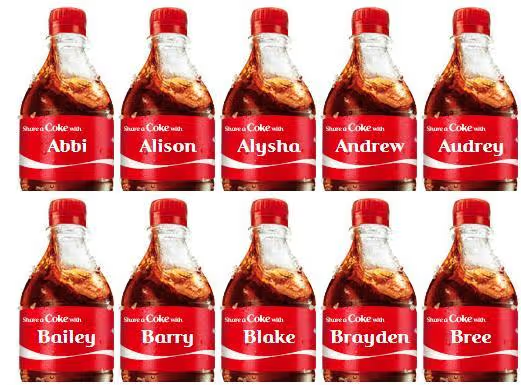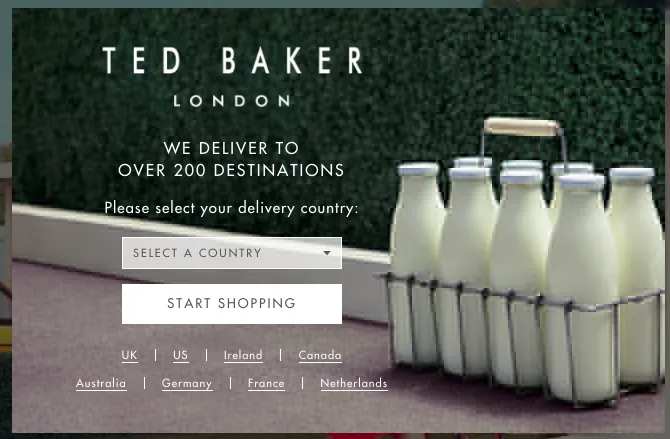What is Personalization in Marketing?
How a personal touch can make all the difference.
Introduction

“Remember that a person’s name is, to that person, the sweetest and most important sound in any language.”- Dale Carnegie, How to Win Friends and Influence People
Think about it: when you’re speaking to someone and they tell you that your eyes are the most beautiful in the world, it makes you feel special.
But if you overheard that same person telling someone else that they have the most beautiful eyes on the planet, you would feel a lot less special, right?
Personalization in marketing aims to make consumers feel like they truly have the most beautiful eyes in the world.
Personalized Marketing Definition
Marketing is all about delivering valuable information at the right place and the right time. But how about delivering this valuable information to the right person?
Personalized Marketing uses customer information, demographics and behavior to determine the best place, at the right time, to the right person.
Using information about customer interests, needs and preferences, marketers are able to tailor their messages to fit the individual customer. This ensures that customers receive the most relevant content at all times.
Personalized marketing not only helps companies deliver more effective messages, but it also allows them to build relationships with their customers by offering a personalized experience. By understanding their customers, companies can create more meaningful connections and ultimately drive higher conversion rates. With the right tools in place, personalized marketing can be a powerful tool for any business.
Why Does Personalized Marketing Work?
A study from the University of Texas concluded that personalization in marketing is about more than just making the consumer feel special.
The study explains that personalized marketing works for two reasons:
1. Information Overload: We’re bombarded with ads everywhere we go. With so many generic ads it all starts to fade away into the background. Personalized marketing cuts through the clutter by providing something that stands out.
2. The Desire for Control: Personalized marketing works for the consumers, filtering out unnecessary information and handing over the control to the consumer. By giving them the option to choose what they see, marketers can give consumers a sense of control over their experience.
Andrew Shapiro, the author of The Control Revolution points out that “our interest in personal control is motivated as much by a survival instinct as by narcissism. It is key to our sense of self-esteem and confidence”
By understanding the benefits of personalized marketing, you can create campaigns that tap into consumer’s desires and give them the control they crave. This will help you to increase engagement, drive conversions and foster a more loyal customer base. It is not just a trend, it’s an essential part of succeeding in today’s competitive market.
What are the Benefits of Personalized Marketing?
The benefits of personalized marketing include:
Increasing Sales: A common goal for personalization marketing is to increase sales, increase the number of times a sale happens and to increase the amount of money spent per sale. To achieve this goal, marketers should make sure they know who their potential customers are and what they’re looking for, creating messaging that speaks to the unique needs of each individual customer—so they’re more likely to take action and convert into sales.
Building Better Relationships: Whether you’re B2B or B2C, we’re all trying to build relationships with our customers. Personalized marketing helps strengthen these relationships. They become more exclusive, genuine, and intimate. The right kind of marketing can make customers feel valued and appreciated.
Take the time to get to know your customers. Learn their interests, their needs, and how they interact with your brand. You’ll have a much better chance of creating content that resonates with them and forms a connection.
Improving the Customer Experience: Tailoring marketing strategies for individual customers improves the experience they have while interacting with your brand. When customers feel valued and understood, they’re more likely to keep coming back. To make sure your marketing efforts are resonating with customers, track their behavior across multiple channels.
Once you have an understanding of what resonates with them, use that information to create custom messages, content and offers that speak directly to their preferences. By going the extra mile to create a personalized experience, you’ll be sure to make every customer feel special.
Grabbing Customers Attention: Personalized marketing increases customer engagement. Showing products customers are actually interested in, delivering messages that mean something, and eliminating unnecessary information.
Tailoring the customer experience to their individual needs makes customers more likely to take action. A great example of this is creating retargeting campaigns that are relevant and timely.
For example, if a customer was viewing an item on your website, you could send them an email with a special offer for that product. This helps to grab their attention and encourages them to complete the purchase.
Getting Customers to Return: As mentioned personalized marketing improves customer experience. A positive experience leaves pleasant memories in the minds of your customers. These experiences can increase the chances that a customer will remember your business when they need to purchase your product/service again.
You can also use the data from customers’ previous purchases to suggest new products or services that you think they might like. This way, you can gently nudge your customer to come back and do business with you. You can even offer rewards for returning customers which will encourage them to return for more of your great service.
Overall, it is important to make sure that your customers have a positive experience with you, so they come back again and again.
Increasing Your Customer Knowledge: Personalization marketing technology runs on data. The more customer data you collect, the easier it is to make informed choices.
As a result, invest in gathering consumer information. Leverage surveys, focus groups and other data gathering techniques to better understand your customers’ needs. Analyze the data you collect to better understand their preferences and buying behaviors. Then use it to create more personalized marketing experiences that increase engagement and loyalty.
What Are the Challenges of Personalized Marketing?
If personalized marketing has so many benefits, why doesn’t everyone do it? Well, gathering data, understanding what the consumer wants, and creating a great offer experience for your consumers is hard without the right tools.
According to Adobe, The biggest challenges with personalization are gaining insight quickly enough, having enough data, and inaccurate data.
However, using the right data, organized in the right fashion, can make understanding consumers’ preferences seem simple.
This type of marketing requires a great deal of time. Developing strategies, understanding customer data and testing different approaches can be a long process. To get ahead, marketers need to invest the time and resources in understanding their customers better.
Last but not least, the biggest challenge is making sure it’s done right. If it’s not, consumers may feel like the messages are intrusive and too personal. In worst case scenarios, they could be spooked away from your brand altogether.
In short, personalized marketing is hard but can be extremely rewarding if done correctly. With the right tools and data to understand customer preferences, you can create a unique experience tailored to each individual customer. It’s time to level up your marketing game and start creating personalized experiences for every one of your customers!
4 Personalized Marketing Examples
Below are four of examples of personalized marketing campaigns. These campaigns highlight the challenges and benefits of personalized marketing.
Amazon

The more I read about personalized marketing, the more I see Amazon’s name pop up. The online retailer is known for creating targeted ads and relevant product recommendations.
Amazon operates using an algorithm called ‘personalized collaborative recommendation systems’.
The algorithm saves a huge list of customer history, categorized into sections such as purchased, liked, saved, wishlisted, etc. If the same customers have shown interest in two categories, then they are marked as related.
Amazon also focuses on general categorizations by labeling categories under names such as ‘travel’, ‘art’, ‘luxury goods’, etc. This helps to make recommendations for groups of consumers who have similar interests in a more broad sense.
Berkeley Professor Michael Jordan, a scientist in Machine Learning, said “Personally I find Amazon’s recommendation system for books and music to be very, very good. That’s because they have large amounts of data, and the domain is rather limited.”
The Results
The ‘buying suggestions’ section alone has generated an additional 10%-30% of revenue.
Ted Baker
Ted Baker is a luxury clothing brand that was looking to expand internationally and digitally.
The company noticed that their competitors were lagging behind when it came to an online presence. So, in the hopes of becoming an online leader, Ted Baker decided to completely renovate its website.
The Problem
The company was concerned with expanding internationally and digitally without being able to maintain the personalized engagement and quality of service it was known for at its physical retail stores.
The Solution
Gender: Ted Baker created two separate website templates based on gender.
Location: Ted Baker researched the unique shopping habits of their consumers based on location, and subsequently designed separate portals for users in the UK, US, Netherlands, France Australia and Canada.
Furthermore, to improve consistency between the online and physical stores, Ted Baker installed a ‘click and collect’ button where consumers can purchase their products online and pick them up in-store.
The opening page for Ted Baker’s website. Here, visitors can choose which country they are shopping from. Currency and product offerings change respectively.

The Results
Ted Baker’s e-commerce sales increase by 64%, which accounted for £43 million of online revenue.
Brainshark
Brainshark is a cloud-based B2B solution that offers a product called myBrainshark, a software that enables users to create and share video presentations easily.
To test the service, Brainshark offers a free premium trial service (or as the company calls it, freemium service).
The Problem
Users were experiencing multiple roadblocks on the path from a free-trial to a paying customer.
After analyzing their customer’s behavior Brainshark discovered what the roadblocks were:
- Users were not uploading presentations
- Users were not sharing presentations
The Solution
Brainshark decided to launch a personalization marketing campaign that displayed actionable tips and tricks for using the product more effectively.
The campaign would only pop up for premium users when they signed into their account or on the product page for users browsing the website.
The Results
Brainshark saw a 15% increase in registrations and a 150% increase in free trial signups
Argos
The Problem
The multi-product retailer, Argos, had a unique problem when it came to personalization – they had too much data stored in multiple non-collaborative systems.
For this reason, Argos was not able to harness its data to create effective personalized campaigns.
The Solution
Argos worked with third-party vendors to build a ‘single customer view’ – a large database that stores and organizes all collected data.
The company was then able to successfully create and launch personalized email campaigns that improved its abandonment rates, sales based on recommendations, and its customer retention rates.
The Results
Each campaign received extremely positive results and the new system accounted for a 4% increase in total revenue.
The Future is Personalization

(Source)
Elle Woulfe, VP of Marketing at LookBookHQ and digital marketing guru shares her thoughts on the future of personalization in marketing:
The next wave of personalization techniques will manifest themselves in offline touches. Smart marketers are tapping into predictive analytics and are using account level buying signals to make sure their sales reps know that a prospective customer has a product need even before the customer does. Brands that successfully implement these technologies and harness all the relevant buying signals stand to achieve a substantial competitive advantage.
In conclusion, these strategies are the key to success. By utilizing the customer data available, companies can create content that specifically addresses their unique needs and interests. This allows companies to connect with their customers on a deeper level and increase engagement, loyalty and sales. As technology advances, we will continue to see more innovative ways of personalizing customer experiences.
How can your business not only be a part of the personalization wave but stay ahead of it?